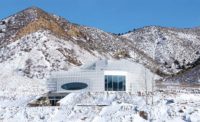This summer, Broadway set designer Mimi Lien is creating a different kind of stage for New Yorkers to enjoy, at Lincoln Center’s Josie Robertson Plaza. With an installation called The Green, Lien has transformed this large outdoor space on Manhattan’s Upper West Side from hardscape into a grassy oasis with a snack bar, shaded seating, and a mobile New York Public Library outpost. The eye-catching venue will host pop-up performances during the warmer months as part of Lincoln Center’s Restart Stages initiative following Covid closures of the past year.
During a brainstorming session on how to make Lincoln Center’s campus more inclusive, Lien—a Tony Award–winner and 2015 MacArthur “genius” grant recipient—pointed out that some aspects of the existing plaza could be viewed as “uninviting.” The concentric pattern of the paving radiating out from the central Revson Fountain (originally designed by Philip Johnson), she says, creates a closed circle. “There’s beauty to the austerity and a breadth to it,” says the Brooklyn–based designer, “but in trying to augment the space for this summer, we thought it might be nice to make it slightly cozier.”
Lien’s design covers the plaza’s granite-paved surface (redesigned by Diller Scofidio + Renfro in 2009) with 14,000 square feet of synthetic grass, adding several anchor-point structures. “When I set out, I was thinking about some kind of topographical intervention to address the vast, flat space of the plaza,” she explains, crediting her undergraduate architecture education at Yale for this thinking. “The architectural conversation has always been part of how I approach set design,” she says.
In one grand gesture, an expanse of turf across the plaza curves upward to 10 feet on the north and south sides to form a “half pipe” shape, covering unsightly construction barriers from Lincoln Center’s multiple ongoing renovations (including the Geffen Hall revamp, which is slated for completion in 2022). It is also “to contain the energy of the performance area” and create raked seating for viewers, says Lien.
For the project, Lien also took cues from Wallace Harrison’s adjacent Metropolitan Opera House, which forms the backdrop of the plaza, by echoing the building’s distinct facade in her own work. Several grass-covered arches (one inverted), all the same diameter as those on the Met, rise from the green plane to form shaded seating areas and shelter a snack bar. “It felt like a nice play on the few curves in this fairly rectilinear space,” she says.
As the summer heats up and the city reopens, New Yorkers will once again be able to comfortably gather outside. “I think of this intervention as an experiment around shaping the way people interact,” says Lien—with each other, the performance venues, and the city. The Green will be open to the public from 9 a.m. until midnight every day through September.





Post a comment to this article
Report Abusive Comment